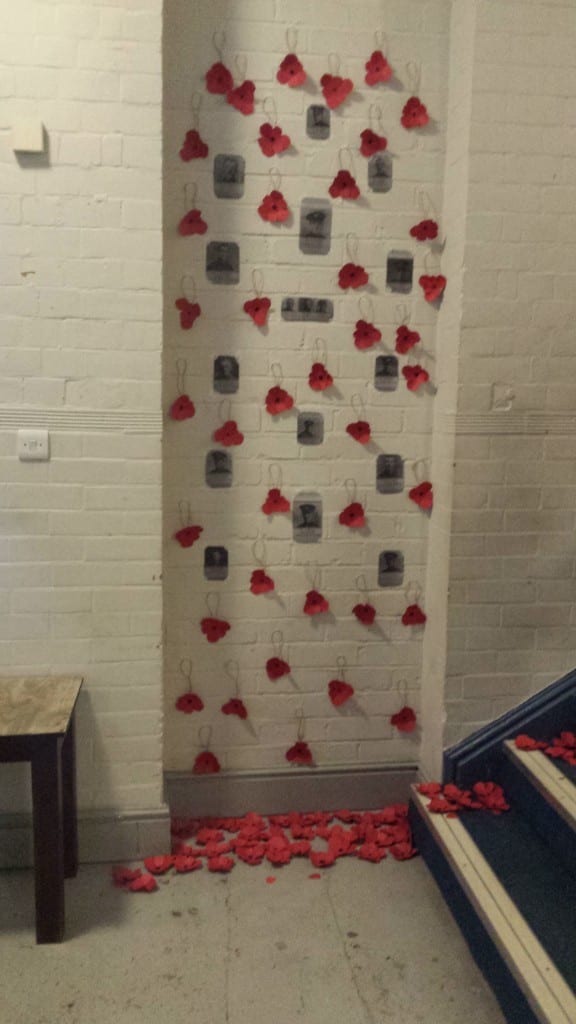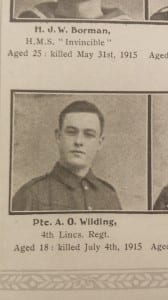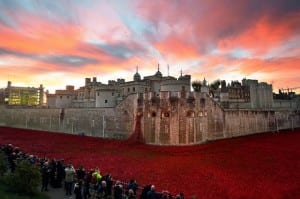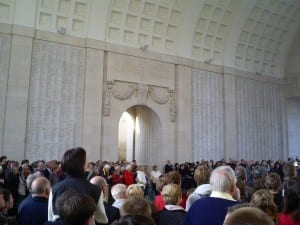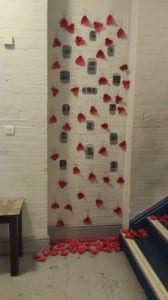(great war, 1998)
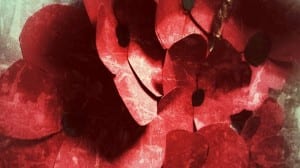 (Moseley, K, 2015) – Our Poppies
(Moseley, K, 2015) – Our Poppies
Framing Statement
Stairway to Heaven is an installation that happened on the 8th of May 2015, where 1915 poppies were dedicated to the soldiers of the 4th Battalion that were trained in the Lincoln Drill Hall before being sent to war in World War One. We were inspired by Blood Swept Lands and Seas of Red, which was a durational installation in the grounds and moat of the Tower of London. This and some other work inspired us to do a durational installation that lasted three hours, in which time we hanged the poppies on the wall. Whilst we were hanging the poppies we had audio with music and war poems interspersed with two minute silences and we spoke the words “in memory of the glorious dead” before taping the poppies to the wall with masking tape.
The floor and stairs were lined with poppies and petals that we had preset along with some of the soldiers pictures on the wall at the bottom of the stairs. We wanted the audience to see the soldiers and be able to form a connection and see some of the people that were from there own birth place. We thought that this would allow the audience to feel more emotion and create a solemn atmosphere. We had signs that told the audience that they could walk through our installation at any point and that should they want to they could chose and hang their own poppy. We wanted the audience to participate in that small way as it would hopefully make them feel more involved and they would have a small lasting legacy that would remain as part of the Drill Hall. We wanted to create an overall atmosphere that we hoped would have a lasting effect, which would be helped by the fact that the drill hall kept our installation on their walls for the near future.
Analysis of the Process
After exploring the Drill Hall and looking at the different points of its history Izzy and I were both interested in the nine names that were on the plaque and decided to work together to somehow bring them home to the Drill Hall, with mementos of their lives. As we researched more into these men we realised that we wanted to do something for all the soldiers of the 4th battalion and not just the ones that were named. We went to the Museum of Lincolnshire life and tried to find anything we could on the soldiers, but as we soon realised researching soldiers can be a lot more complicated than we first thought. Not only did they have the 4th Battalion but they had the 1/4th and so on, which after going to the archives we realised were all the same battalion. Therefore we didn’t get much research until we went to the archives, where they had the information we wanted as well as the pictures and names of the men.
This is just one of the many that we found.
(archive, 2015)
We chose our first space as the balcony, as it was where the officers stood and watched the soldiers drill, and we wanted to have poppies involved with all the names of the soldiers. We struggled with how we were going to do all that wanted to in the time that we had and realised we needed to simplify our idea. One day when we could not get on the balcony we were playing with ideas on the staircase at the back of the Drill Hall and realised that we could cover the stairs in poppies as a memorial for the soldiers.
“we are frequently nostalgic for places we have left” (Cresswell, 2004, 21).
This could be said for a variety of places and rooms, however not many people really think of this with stairs, they are usually just thought of as a way to get from one floor to the next. This was one of our reasons for working at this site as not many people really expect to see a performance on a staircase or for it to really mean anything, and we were therefore bringing meaning to them. Also with stairs comes the idea of liminal spaces which is “the boundary of two dominant spaces, which is not fully part of either” (Dale and Burrell, 2008: 238). As we had decided we were going to work on the stairs we thought that this would be a good theory to work with. Not only was the physical space liminal, but the soldiers had also been in a liminal space, between life and death, and we were in a way bringing them back to life.
Places don’t really mean anything until you have connected to it or done things there to create memories. As the staircase was at the back of the Drill Hall, which was once the front, it had a neglected feel as if it had no special place within the building anymore. “It is through participating in theses daily performances that we get to know a place and feel part of it” (Cresswell, 2004, 34). By exploring the stairs and running different ideas of what we could do or how we wanted our installation to look, we became familiar to the space and it no longer was an empty staircase at the back of the Drill Hall. It began to mean something to us and we hoped with the sight and memories of the poppies it would mean something to the Drill Hall as well.
We then planned to make 8000 poppies as an installation for all the soldiers from Lincoln. After a while we realised how big a task this was and that we wouldn’t be able to make them all in the time we planned, as well as put them all up in the performance time. We then decided to make 1915 poppies to mark the 100 years that had passed since World War One. We thought about buying real poppies, but decided that would cost too much money and we wanted the poppies to be able to last and not die. We then searched on YouTube and found a video that seemed to make quite simple designs. With a few of our own alterations we had found our design.
Follow this link to see the step by step video.
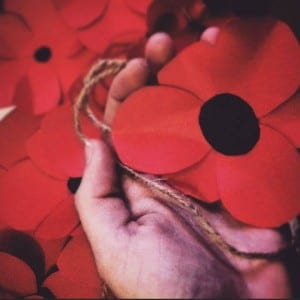
Exploring the idea of limbo more we later thought to curl and cradle the poppies in our hands before hanging them so as to symbolise giving life to the soldiers. Then at the end when Izzy did the roll call of the soldiers names, I would drop a poppy on every name to symbolise that the soldiers had returned to death and laid to rest at the Drill Hall.
Inspirations
Before this module I did not know what an installation was, so after some research Izzy and I were inspired by the installation that took place at the Tower of London, to mark the one hundred years since World War One. It was called Blood Swept Lands and Seas of Red which was created by artists Paul Cummins and Tom Piper, that had 888,246 ceramic poppies which filled the grounds of the Tower of London over a period of time between the 5th August and the 11th November 2014. Each poppy represented a British fatality during World War One. We really liked this installation as it made you confront the reality of how many soldiers died during those few years. “Few art installations of any kind have caught the public imagination as have the 888,246 ceramic poppies that filled the moat of the Tower of London.” (ceramic review). This shows how much this installation caught the attention of England as well as all over the world. During the installation the public could buy a ceramic poppy that would be sent to them after it had been finished, which allowed the audience to become involved and also allowed the installation to carry on in homes all over the United Kingdom. This gave us the idea to have the audience participate in our piece somehow.
Photo takehttp://www.standard.co.uk/news/london/remembrance-day-last-ceramic-poppy-planted-at-tower-of-london-to-mark-100-year-anniversary-of-first-world-war-9853203.html
We wanted to do something like this for our piece and help Lincoln understand how many soldiers died just from that one battalion. The reason we wanted to use poppies was because it is the universal sign of respect to fallen soldiers and we thought this was a good idea to show our respect and also bring them home to the Drill Hall. The poppy is the symbol that we use as during the war “once the conflict was over the poppy was one of the only plants to grow on the otherwise barren battlefields” (BBC, 2014). This is a symbol that everyone knows and understands and therefore it would hopefully bring an immediate reaction to our installation. We wanted to hang the poppies because it would represent that we were giving the soldiers as medals to the Drill Hall and we were sticking them with masking tape to represent the bandages of the injured and dead, reminding the audience what the soldiers may have gone through. We wanted to have audio in the background with war poems and music with the soldiers names that would play for the three hours with two minute silences interspersed throughout and would hopefully all come together to create an emotional and respectful atmosphere.
I was also inspired by the Menin Gate in Ypres, which was designed by Reginald Blomfield and opened in July 1927, to commemorate the 56,000 fallen British and Commonwealth soldiers of World War One who have no known grave. The Menin Gate is at the eastern exit to the town which Allied soldiers used to get to the front line. Every day at the same time they have a ceremony without fail with a two minute silence and the last post. I have been to Ypres and saw this when I was younger and was struck by how many names lined the walls as well as the amount of people that turned up every day for the ceremony. I was overcome by the atmosphere surrounding this gate and the thousands of names that surrounded me. There were many people that were crying or looking for names of members of their family and I was overcome by the emotion and honesty of this place even though none of my relatives are on the walls. I wanted some part of this to be in our performance because I remember it had such an atmosphere that immediately struck you and made you become reflective of the world and yourself. This is when we decided we should have some sort of ceremony to memorialise the soldiers.
Photo taken from http://en.wikipedia.org/wiki/Menin_Gate
At the end of the installation at 5 o’clock we would go to the top of the stairs and do a memorial where we would read For the Fallen by Robert Laurence Binyon and then have a two minute silence with the audience before playing the last post, which everyone is familiar with as it is performed at every remembrance ceremony. After making our first audio we realised we were speaking too fast and that the music under the recordings made it all very melodramatic. After Michael saw our piece he advised us to have the music and poems separate, and instead of having the soldiers names recorded we would read them out at the end instead of the poem. I really liked this idea as it reminded me of all the names on the Menin Gate and we would hopefully be able to create the atmosphere that I felt during this last part of our performance.
Another piece that inspired me was by Stan’s Cafe. “Of All The People In All The World uses grains of rice to bring formally abstract statistics to startling and powerful life” (Stan’s cafe, 1992). This piece used grains of rice that represented individual people and would be put into piles of statistics such as the populations of towns or the amount of people that die each day. I really liked that some of this work shocked the audience by how high the piles were according to the statistics. For our piece we wanted to shock our audience with how many young people died just from Lincoln.
At the archives we found pictures of the soldiers, with information of their age and the date that they died. We were shocked by this information because most of them were young, with the youngest being only 16 years old when he died. Also we were faced with the knowledge that most of these soldiers were younger or a similar age to us when they died and I found it quite hard to come to terms with that fact. We found out that a lot of the soldiers had died on the 13th of October 1915 and with further research we found that this was because of the Hohenzollern Redoubt, a mission that was during the Battle of Loos just before the famous Battle of the Somme, that failed and lost a lot of men. We thought we could use the connection of 100 years since this battle in 1915 in our performance. I wanted to have pictures of the soldiers on the wall at the bottom of the stairs so that the audience could understand what we were doing and also be able to connect with the individual soldiers as well. We thought that by being able to see the pictures it would have a more emotional impact on the audience as they may never seen any of the soldiers before and can relate to them as they were from where they live.
Performance Evaluation
Follow this link to a video of our installation
https://www.youtube.com/watch?v=B4XjYIMFLsw&feature=youtu.be
On the performance day we preset some poppies on the floor of the stairs as well as poppy petals, we also put pictures of some of the soldiers on the wall at the bottom of the stairs surrounded by poppies.
(Moseley, K, 2015) The soldiers pictures.
In our installation we wanted the audience to feel involved with our work. “Through their physical presence, perception, and response, the spectators become co-actors that generate the performance by participating in the “play”” (Fischer-Lichte, 2008, 32). The audience had the choice to pick their own poppy and hang it on the wall. We were surprised that the majority of audience members did participate, also by watching us they also said the words ‘in memory of the glorious dead’ as they hung them. This was a pleasant surprise as we were not expecting the audience to say anything when they hung their poppies and it made me feel as though the audience were a bigger part of our installation. I also think this worked really well because if the audience had no part in our installation it would not have been as emotional or unified in our respect for the soldiers.
As we chose a poppy we bent them and clasped them in our hands to give them life, as though we were bringing the soldiers back to the Drill Hall. At the end of the memorial as Izzy read the names of the soldiers I dropped a Poppy per name, letting the soldiers return to death. As we were exploring the idea of liminal spaces, we put less poppies the further up the stairs and this was to symbolise that we do not know much about limbo in the sense of in between life and death and therefore there would be less poppies to show this. Also by dropping the poppies at the top of the stairs onto the landing it was showing that the soldiers were dead and we were putting them to rest in the place that they had drilled before going to war. I think this worked very well and had the image that we thought it would, but I think without more explanation the audience may not have understood the process.
One of the things that didn’t go as well was the two minute silences throughout the audio. As we were absorbed in the piece and there was a lot of sound from other performances as well as passing traffic sometimes we did not realise that the silence had begun and quickly stopped once we realised. If we were to do this piece again I would either mark when the two minute silences began so we knew to stop or record a small piece asking the audience to join us in the two minute silence as it was clear at times that some people did not understand why we had stopped. I would also hope to have only low background noise as it sometimes interfered with the atmosphere we were creating and the audience may not have been caught up in the moment as we hoped would happen.
I think that the audience being able to walk around our installation freely and not having to stay in the area really worked as it meant that they could see the different stages of our installation as it came together. However I would have advertised the memorial at the end more so we could have had more of an audience for the part where we collectively showed our respect. I think with more people it might have had more of an impact, but even with just a few people it was still what we wanted it to be.
The poppies on the wall looked a lot better than I initially thought it would and I found myself getting more emotional the more poppies went up. If we were to do this again I would like to attempt it with more time and more poppies to completely fill the staircase and see how that would have worked. Also with longer breaks as it was very exhausting not only physically but emotionally and mentally. Both Izzy and I had formed attachments to the soldiers we had researched especially because we had been doing it for so long, therefore I found this piece very cathartic as we were paying our own tribute to the soldiers and bringing them back to the Drill Hall.
I feel proud of the work Izzy and I did and feel that we gave the soldiers justice in our tribute to them. We were also pleasantly surprised that the Drill Hall wanted to keep our installation on the stairs, meaning that for now our performance and tribute is still continuing within the Drill Hall and will do so for the near future.
BBC (2014) Ninety years of remembrance. [online] London:BBC. Available from http://www.bbc.co.uk/remembrance/how/poppy.shtml [Accessed 14 May 2015].
Caroline Gaudette (2012) DIY – Poppy flower made of paper. [online video] Available from https://www.youtube.com/watch?v=qcphpOKt3fs [Accessed 10 March 2015].
Ceramic review. (2015) Remembrance Day: The Ceramic Poppies at the Tower of London. Ceramic Review, (271) 79-79.
Cresswell, T. (2004) Place: a short introduction. Oxford: Blackwell Publishing.
Dale K and Burrell G (2008) The Spaces of Organization and the Organization of Space: Power, Identity and Materiality at Work. London: Palgrave
Fischer-Lichte. (2008) The Transformative Power of Performance: A new aesthetics. Abingdon: Routledge. Trans Sasykya Iris Jain.
Great War. (1998) The Great War 1914-1918. [online] Available from http://www.greatwar.co.uk/poems/laurence-binyon-for-the-fallen.htm [Accessed 13 May 2015]
Kay Moseley (2015) Stairway to heaven. [online video] Available from https://www.youtube.com/watch?v=B4XjYIMFLsw&feature=youtu.be [Accessed 14 May 2015].
Stan’s Cafe. (1992) Stan’s Cafe Theatre Company. [online] Birmingham: Stan’s Cafe. Available from http://www.stanscafe.co.uk/project-of-all-the-people.html [Accessed 13 May 2015].
Visit to Lincolnshire Archives 13 February 2015.
